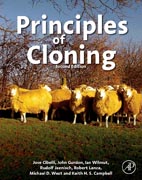
Principles of Cloning
Cibelli, Jose
Wilmut, Ian Sir
Jaenisch, Rudolf
Gurdon, Sir John
Lanza, Robert
West, Michael
Campbell, Keith H.S.
Principles of Cloning, Second Edition is the fully revised edition of the authoritative book on the science of cloning. The book presents the basic biological mechanisms of how cloning works and progresses to discuss current and potential applications in basic biology, agriculture, biotechnology, and medicine. Beginning with the history and theory behind cloning, the book goes on to examine methods of micromanipulation, nuclear transfer, genetic modification, and pregnancy and neonatal care of cloned animals. The cloning of various species-including mice, sheep, cattle, and non-mammals-is considered as well. The Editors have been involved in a number of breakthroughs using cloning technique, including the first demonstration that cloning works in differentiated cells done by the Recipient of the 2012 Nobel Prize for Physiology or Medicine - Dr John Gurdon; the cloning of the first mammal from a somatic cell - Drs Keith Campbell and Ian Wilmut; the demonstration that cloning can reset the biological clock - Drs Michael West and Robert Lanza; the demonstration that a terminally differentiated cell can give rise to a whole new individual - Dr Rudolf Jaenisch and the cloning of the first transgenic bovine from a differentiated cell - Dr Jose Cibelli. The majority of the contributing authors are the principal investigators on each of the animal species cloned to date and are expertly qualified to present the state-of-the-art information in their respective areas. First and most comprehensive book on animal cloning, 100% revisedDescribes an in-depth analysis of current limitations of the technology and research areas to exploreOffers cloning applications on basic biology, agriculture, biotechnology, and medicine INDICE: List of Contributors.Preface. Introduction.Historical Perspective. PART ONE-BASIC BIOLOGICAL PROCESESActivation of Mammalian Oocytes. The Nucleus. Nuclear Reprogramming: Biological and Technological Constraints.Plasticity of Somatic Nucleus by Epigenetic Reprogramming via Cell Hybridization. Cell Cycle. Determinants of Pluripotency in Mammals.Cloning and Aging.PART TWO-METHODSMicromanipulation Techniques for Cloning. Microinsemination and Nuclear Transfer with Male Germ Cells. Development of Viable Mammalian Embryos in Vitro: Evolution of Sequential Media.Genetic and Phenotypic Similarity Among Members of Mammalian Clonal Sets. Genetic Modification and Cloning in Mammals. Pregnancy and Neonatal Care of Clone Animals. Donor Cell Type and Cloning Efficiency in Mammals.PART THREE-CLONING BY SPECIESThe Cloning of Amphibians. Cloning of Fish. Cloning of Mice. Cloning of Rabbits. Nuclear Transfer in Swine. Cloning of Cattle. Cloning of Sheep. Cloning of Goats. PART FOUR-CURRENTLY SOUGHT AFTER SPECIESCloning of Endangered Species. Cloning of Rats. PART FIVE-NUCLEAR TRANSFER IN PRIMATESCloning in Non-Human Primates.PART SIX-APPLICATIONSNuclear Transfer for Stem Cells (CRNT). Current Research and Commercial Applications of Cloning Technology. Transgenic Cloned Goats and the Production of Therapeutic Proteins. PART SEVEN-ETHICAL AND LEGAL AFFAIRSEthical Implications of Cloning.FINAL REMARKSMammalian Cloning- Challenges for the Future.
- ISBN: 978-0-12-386541-0
- Editorial: Academic Press
- Encuadernacion: Cartoné
- Páginas: 572
- Fecha Publicación: 19/11/2013
- Nº Volúmenes: 1
- Idioma: Inglés
